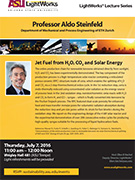Jet Fuel from H2O, CO2, and Solar Energy
Aldo Steinfeld
- Professor, Department of Mechanical and Process Engineering, ETH Zurich
The entire production chain for renewable kerosene obtained directly from sunlight, H2O, and CO2 has been experimentally demonstrated. The key component of the production process is a high-temperature solar reactor containing a reticulated porous ceramic (RPC) structure made of ceria, which enables the splitting of H2O and CO2 via a 2-step thermochemical redox cycle. In the 1st reduction step, ceria is endo-thermally reduced using concentrated solar radiation as the energy source of process heat. In the 2nd oxidation step, nonstoichiometric ceria reacts with H2O and CO2 to form H2 and CO – syngas – which is finally converted into kerosene by the Fischer-Tropsch process. The RPC featured dual-scale porosity for enhanced heat and mass transfer: mm-size pores for volumetric radiation absorption during the reduction step and µm-size pores within its struts for fast kinetics during the oxidation step. We report on the engineering design of the 4 kW solar reactor and the experimental demonstration of over 290 consecutive redox cycles for producing high-quality syngas suitable for the processing of liquid hydrocarbon fuels.
Light refreshments will be served.
11:00 a.m. - 12:00 p.m.



